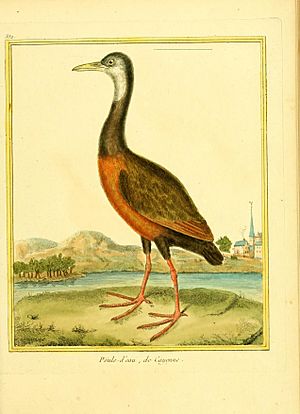Brown wood rail facts for kids
The brown wood rail (Aramides wolfi) is a special type of bird. It belongs to the rail, crake, and coot family, called Rallidae. This bird is considered a Vulnerable species, meaning it needs our help to survive. You can find it living in Colombia and Ecuador.
Quick facts for kids Brown wood rail |
|
|---|---|
 |
|
| Conservation status | |
| Scientific classification | |
| Genus: |
Aramides
|
| Species: |
wolfi
|
 |
|
Contents
About the Brown Wood Rail
Scientists study and name all living things. The brown wood rail is unique because it is the only species in its particular group. This means it doesn't have any close relatives that are also called 'brown wood rails'.
What Does the Brown Wood Rail Look Like?
The brown wood rail is about 33 to 36 centimeters (13 to 14 inches) long. Both male and female birds look the same.
Colors and Features
Adult brown wood rails have a yellow-green beak. Their eyes are red, and their legs and feet are pink. Their head is a gray color, like ash. They have a small yellow spot on their forehead. Their throat is a pale color. The tail, sides, and belly of the bird are black. The rest of their body is a warm brown color. Young brown wood rails have not been fully described yet.
Named After a Naturalist
The scientific name for this bird, wolfi, honors a German naturalist. His name was Theodor Wolf.
Where Do Brown Wood Rails Live?
The brown wood rail lives in parts of western Colombia and western Ecuador. It is found in scattered locations. There was a report of this bird in Peru in 1977. However, this report was later found to be incorrect.
Habitat Preferences
These birds like to live in many different wet and dry places. You might find them in mangrove forests. They also live in freshwater marshes and swampy woodlands. River bottoms and both old and new forests are also good homes for them. They can live from sea level up to about 900 meters (3,000 feet) high.
How Do Brown Wood Rails Behave?
Staying in One Place
The brown wood rail seems to live in the same area all year long. It does not appear to migrate or move to different places.
What Do They Eat?
Scientists do not know much about what the brown wood rail eats. They also don't know how the bird finds its food. This is an area that needs more study.
Building Nests and Raising Young
In Ecuador, brown wood rails lay eggs from at least February to April. Their nests are like open cups. They are made from large dead leaves and pieces of vines. These nests can be found in different spots. Some are on tree stumps or tangled branches. Others are in small shrubs close to the ground. They are usually between 1.2 and 2.6 meters (4 to 8.5 feet) high. A female brown wood rail usually lays two to four eggs. The eggs hatch after at least 19 days.
Their Calls
One of the calls the brown wood rail makes sounds like "kui-co-mui." They repeat this sound.
Protecting the Brown Wood Rail
The IUCN (International Union for Conservation of Nature) keeps track of animals. They first said the brown wood rail was "Threatened." Since 1994, they have listed it as "Vulnerable." This means the bird is at risk of disappearing.
Why They Are Vulnerable
The brown wood rail is found in only a few places. Experts believe there are only about 1,000 to 2,500 adult birds left. Their numbers are going down quickly. This is mainly because their homes are being destroyed. There is an urgent need to learn more about this bird. We need to find out how many there are and how they live. This will help us protect them better.
See also
 In Spanish: Chilacoa café para niños
In Spanish: Chilacoa café para niños


